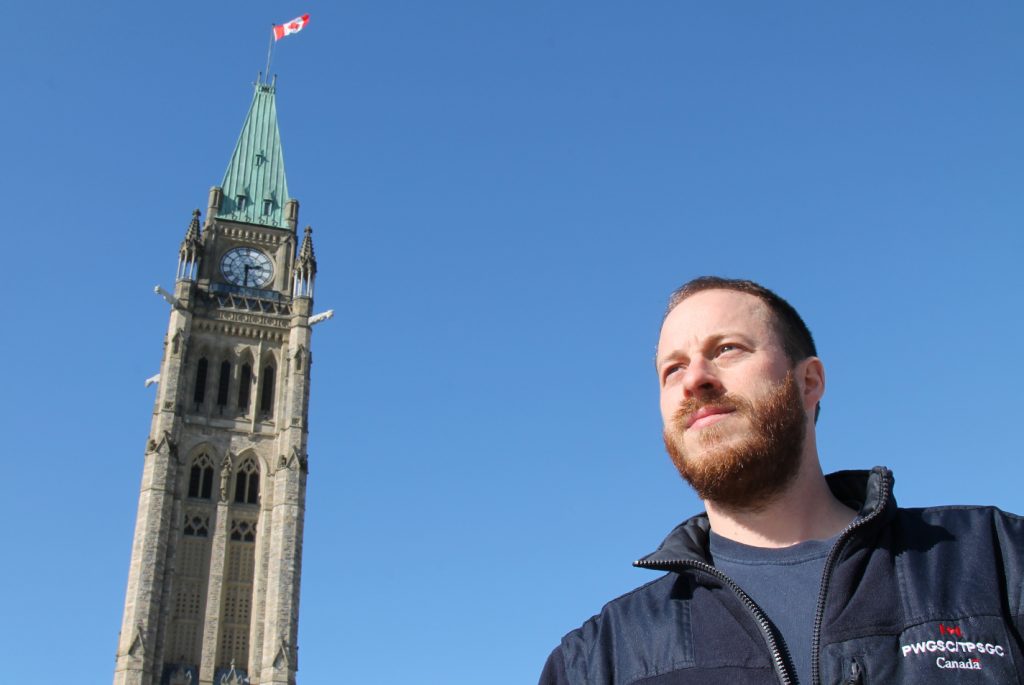Hill’s flag man flies high in 2017
By Anna Sophia Vollmerhausen
When Robert Labonté was a kid growing up in New Liskeard, he painted a large Canadian flag on his closet door.
Now, the 34-year-old federal public servant is the man responsible for displaying the country’s single most important flag: the one atop the Peace Tower on Parliament Hill.
For the last seven years — once a day, five days a week — Labonté will sign out a flag that’s almost three times the size of a king-sized mattress, and head up the tower to latch it to the Peace Tower’s flag pole, pausing only briefly to fist bump one of the lion statues at the bottom of the historic building.
If the elevator is working, he will only have to climb 141 steps from the observation deck to the top.
If it’s not, he’ll climb up 392 steps from the ground floor to the tower top, change the flag, and take the stairs back down. His record to complete the task, he said, is just under eight minutes.
“It’s torture,” Labonté said. “But I mean, you gotta have fun with it. So when the elevator’s not working, if it’s not working for a couple of days, I’ll usually time myself and try to do it quicker.”
After he’s changed the flag, while making his way down the tower, Labonté said he performs a solo rendition of O Canada.
“I always sing bilingually. Basically it’s the way I learned when I was a kid watching hockey with my dad,” he said.
According to Labonté, singing seemed like the natural thing to do.
“I mean, you’re by yourself so it’s the perfect time to sing, or it is in my case anyways,” Labonté said. “It’s very enlightening, it’s very solemn, so I, just out of the blue one day, started to sing.”
There’s just one rule for the whole process, an age-old imperative meant to preserve the sanctity of a nation’s most potent symbol: don’t let the flag touch the ground.
“That’s the big one,” he said.
According to Labonté, one of his most memorable days was when the flag turned 50 years old on Feb. 15, 2015 — five decades, to the day, after former prime minister Lester B. Pearson first unveiled the Maple Leaf on Parliament Hill in 1965.
Other occasions also stand out, too, such as Canada Day every year, and Prince William’s visit in 2011.
“Whenever we celebrate anything, whenever there’s a gathering of people, those are special,” he said.
Labonté thinks the 50th anniversary of the flag has made Canadians more appreciative of what it represents.
As the country gears up for Canada’s 150th anniversary celebrations this year, Labonté said the flag becomes a symbol that represents the entire country.
“It’s a big year, a special year this year,” he said.
But flags are not all about celebrating.
As flag master, Labonté is also responsible for putting the flag at half-mast when the nation is grieving a particularly tragic loss — such as the one suffered in January when a gunman killed six people at a mosque in Quebec City — or paying tribute upon the passing of a great Canadian, such as the late member of Parliament, Mauril Bélanger.
“When we went to half-mast after the (2015 terror) attacks on Paris, when we went to half-mast following the attack on Parliament Hill on Oct. 22 (2014), I remember going up there the next morning and having to put the flag at half-mast… that was something very special that I hope will never have to be re-lived,” he said.
“You’re up there by yourself, you’re doing basically the country a favour (but) in fact, they’re doing me a favour by letting me do it.”
“When I started maintaining buildings, my goal from the get-go was to get to Parliament Hill, but I didn’t know the flag was part of that,” he said. “When I finally made it to Parliament Hill and I found out about it— (life)-changing—I was all over that and have been ever since.”
He added: “To be able to say that you’re the one that keeps the building up and standing and operating, I mean that’s the ultimate—that’s like winning the Stanley Cup.”
Canadians who are willing to add their names to a 63-year-long waitlist can request to have a flag that flew on the Peace Tower sent to them. Citizens who don’t want to wait that long, can also request any of the other flags that have flown on Parliament Hill—the wait list for these is only 50 years.
The Peace Tower flag, which measures 2.3 metres by 4.6 metres, is changed every working day, and is tagged, folded and stored before the Ministry of Public Services and Procurement mails them out.
Despite being up close with the flag every day, Labonté said he is no different than the thousands of other government workers in the capital.
“I’m a simple public servant,” Labonté said. “You know, I’m not special in any way, so if I want a flag I need to put my name on the list and wait.”
Changing the flag is never a routine thing for Labonté, who added that the feeling of being at the top of the tower is “like nothing else.”
“I’ve been doing it for a while, and I’ve seen big rain storms, hail storms, I’ve seen sunrises, sunsets. I’ve been there, where I couldn’t see three feet in front of me; I’ve been above the clouds. I’ve seen birds fly below me. You see so many different things,” Labonté said. “I mean, you could do it at the same time every day and it’ll be different every day. It’s just surreal, it’s special.”
“You’re up there by yourself, you’re doing basically the country a favour,” he said. But, “in fact, they’re doing me a favour by letting me do it.”

